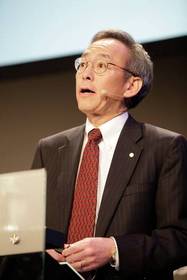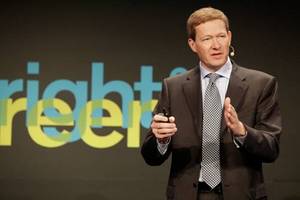Contact Information: For More Information Contact: Jamie Wenrich Godfrey PR (717) 393-3831, ext. 204 jwenrich@godfrey.com
Danfoss President Sees Opportunities for Energy Efficiency in Wake of COP15
Today's Technologies Will Advance Energy Efficiency, Create Jobs and Save Money
| Quelle: Danfoss
BALTIMORE, MD--(Marketwire - January 5, 2010) - Although the delegates to the 15th United
Nations Climate Change Conference (COP15) Dec. 7 - 18 in Copenhagen failed
to agree on a legally binding replacement of the Kyoto Protocol, many
opportunities already exist to save energy and reduce carbon emissions
through improved energy
efficiency in homes, schools, offices and other commercial buildings.
"While it's true that the removal of political and economic barriers would
provide a significant boost to global energy efficiency, it's important to
remember that many of today's technologies produce the desired effect --
improving energy efficiency, saving money and reducing carbon emissions in
the process," said Robert Wilkins, president of Danfoss North America.
Danfoss, an official sponsor of COP15 through its association with the
Confederation of Danish Industry (DI), co-sponsored a reception in
Copenhagen immediately following the Alliance
to Save Energy (ASE) forum on Dec. 14. U.S. Energy Secretary and Nobel
Prize winner Dr. Steven Chu addressed the reception and reiterated the
Obama Administration's emphasis on energy efficiency, "...not just as
low-hanging fruit, but as fruit already on the ground," ready to be picked
up. Sec. Chu went on to say, "Energy efficiency means saving money as well
as saving the planet."
"The increased emphasis on energy efficiency will provide a boost for our
industry, leading to both job creation and energy savings," Wilkins
remarked. "With the appropriate incentives, millions of old, inefficient
air-conditioning, heating and refrigeration systems in the field could be
replaced with today's much more efficient equipment or tomorrow's
super-efficient equipment being developed today utilizing variable frequency drive (VFD) technology."
One incentive already benefitting Americans is the result of The American
Recovery and Reinvestment Act of 2009. This legislation provides tax
incentives to homeowners -- credits as high as 30 percent of the installed
cost, or up to a total of $1,500 of residential projects installed from
Jan. 1, 2009, through Dec. 31, 2010 -- for qualified improvements with
high-efficiency heating and air-conditioning systems.
Prior to his appearance at the ASE reception, Sec. Chu announced a $350
million initiative, the Climate Renewables and Efficiency Deployment
Initiative, designed to encourage the rapid deployment of renewable energy
in developing countries. He pledged that the United States will contribute
$85 million to the fund.
According to Wilkins, the broader the applications of energy efficient
technologies, the greater the benefits would be. "The implications for the
United States alone are significant," he noted. "Improved energy
efficiencies means reducing our dependence on foreign energy supplies,
increasing energy security, improving our balance of trade, reducing the
toll that energy costs have on our economy, and reducing surface
pollution."
Copenhagen Accord Signals Step Forward
But, the United States is only one player in a global team needed to reach
agreement on actions for reducing global greenhouse gas emissions. Albeit
controversial, the Copenhagen Accord, which was drafted and released on the
final day of the Conference, cites critical, though non-legally binding,
agreements seeking cooperation between developed and developing countries.
The Accord notes the importance of a low-emission strategy for sustainable
social and economic development while combating climate change.
In its most recent draft, the Accord calls, in part, for the following:
-- Global emissions cuts of 50 percent (based on 1990 levels) by 2050;
-- Emissions cuts by developed countries of 80 percent by 2050;
-- A commitment of $30 billion from developed countries in 2010-2012 to
help developing countries adapt and meet goals.
Regarding mitigation actions by developing countries, the Accord does not
contain any specific emissions reductions objectives. It mainly elaborates
on the measurement, reporting and verification of developing country
actions, which was one of the major stumbling blocks in the negotiations
leading to Copenhagen.
The Accord contains a compromise between U.S. and China stating that there
will be provisions for 'international consultations and analysis.' And,
what experts believe to be the most successful part of the Accord relates
to short and long-term financing -- $30 billion from 2010 - 2012 and an
additional $100 billion a year by 2020 will be mobilized from a variety of
sources.
The Copenhagen Accord, however, did not agree on specifics for controlling
and phasing down high global-warming-potential (GWP) HFC
(hydrofluorocarbon) refrigerants. Earlier, the U.S., Canada and Mexico
formally proposed including HFCs in the Montreal Protocol, which has been a
very effective global process for reducing ozone-depleting substances
including CFC (chlorofluorocarbon) and HCFC (hydrochlorofluorocarbon)
refrigerants. That proposal has been supported by the European Union and
other countries, and is expected to advance during 2010 regardless of the
broader climate change issue.
"While Copenhagen did not produce a legally-binding global Climate Change
agreement," Wilkins concluded, "it certainly heightened awareness that
energy efficiency is the most viable way to reduce carbon emissions, while
saving money and reducing dependence on volatile foreign energy sources."
Related Links:
Danfoss Solutions Ready! - www.danfoss.com/SolutionsReady/
Alliance to Save Energy - www.ase.org
Danfoss Variable Speed Drives -
http://www.danfoss.com/businessareas/refrigerationandairconditioning/products/group/
ra/electronic-controls/electronic-controls-speed-control-of-compressors-condensers-and-fans/variable-speed-drives/e46607a0-cacc-43e0-8841-98fa971ec28c.html
About Danfoss:
Danfoss is one of the world's leading manufacturers of electronic and
mechanical components and control systems for refrigeration and air
conditioning, heating, and motion controls. We operate in more than 100
countries, employ 22,300 people, and hold more than 1,800 patents on a wide
range of products. Our innovative, reliable products are backed by local
sales and support to help our customers solve their greatest challenges.
With its visionary and committed employees, Danfoss meets the needs of its
customers through its EnVisioneering(SM) partnerships. EnVisioneering focuses
on developing new technologies for sustainable business growth through
engineering innovation, energy efficiency and environmental responsibility.
For more information about Danfoss, visit: www.danfoss.us. For more
information about EnVisioneering, visit: www.envisioneering.danfoss.com.

